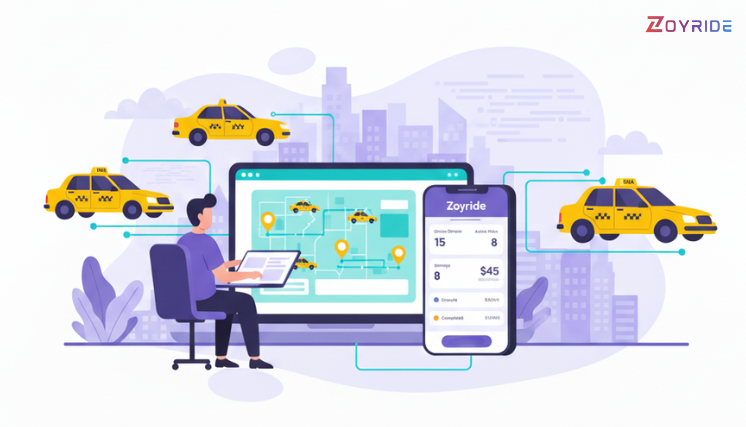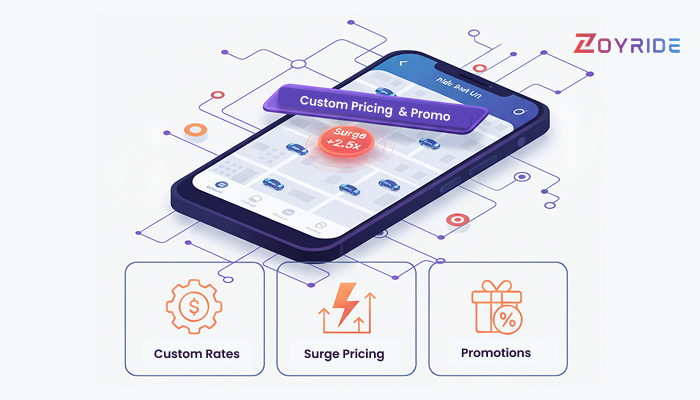
The taxi industry is no longer just about phone calls, cash fares, and handwritten trip logs. In today’s fast-paced world, passengers expect convenience, transparency, and speed — all through their smartphones.
For local taxi operators, this shift can seem overwhelming, but it’s also a huge opportunity.
White label solutions make it possible for even small or mid-sized taxi businesses to launch their own branded ride-hailing platform without building everything from scratch.
In this blog, we’ll explore how local taxi operators can go digital using white label technology, why it’s a game-changer, and how to make the transition smooth.
1. Understanding White Label Solutions for Taxis
A white label solution is a ready-made software platform that can be rebranded and customized with your logo, colors, and business features.
Think of it as renting a fully built taxi app — but it looks and feels like it’s 100% yours.
Key components usually include:
- Passenger booking app (iOS & Android)
- Driver app for accepting and managing rides
- Admin dashboard for dispatch and analytics
- Payment gateway integration
- GPS-based tracking and route optimization
This means you don’t need to hire a large tech team or spend months developing an app.
2. Why Local Taxi Operators Should Go Digital
The benefits of going digital go far beyond just “having an app” — it’s about using the right taxi software to transform how you operate and serve your customers. Here’s why it matters:
- Meet customer expectations – Riders want instant bookings, live tracking, and cashless payments.
- Stay competitive – Compete with big brands like Uber or Ola without losing your local advantage.
- Increase efficiency – Automated dispatching reduces idle time and maximizes trips per shift.
- Data-driven decisions – Access trip reports, revenue data, and performance metrics in real time.
- Build brand loyalty – A personalized app keeps customers coming back to your service.
3. Steps for Going Digital with a White Label Taxi App
Transitioning to digital operations doesn’t have to be complicated. Here’s a clear roadmap:
Step 1: Define Your Needs
- Do you need only ride-hailing or multiple services (rentals, shuttle, freight)?
- What payment options do your customers prefer?
- Will you operate in a single city or multiple regions?
Step 2: Choose the Right White Label Partner
Look for:
- Reliable technology stack (fast, secure, scalable)
- Custom branding options
- Strong dispatch and route optimization features
- Multi-language and multi-currency support if you have a diverse customer base
Step 3: Customize Your Platform
- Add your logo, colors, and brand tone
- Configure pricing, commission rates, and service areas
- Integrate local payment gateways
- Set up loyalty programs or referral discounts
Step 4: Train Your Team & Drivers
Even the best software needs skilled operators. Provide:
- App usage training for drivers
- Guidelines for customer service
- Tips for maximizing trips and ratings
Step 5: Launch & Promote
- Announce your new app on social media
- Offer launch discounts or free rides to early adopters
- Partner with local businesses for cross-promotions
4. Features to Focus on for Local Success
- Real-time GPS Tracking – Builds trust and improves safety.
- Automated Dispatch – Ensures the nearest available driver gets the ride.
- Surge Pricing & Promotions – Adjust prices during high demand and attract customers during low hours.
- Multiple Payment Options – Cash, cards, wallets, and UPI for convenience.
- Driver Ratings & Reviews – Maintain service quality.
5. Overcoming Common Concerns
“What if my drivers are not tech-savvy?”
White label apps are designed to be user-friendly, with simple navigation and minimal steps.
“Isn’t this expensive?”
Compared to building from scratch, white label solutions are much more cost-effective. You pay for a proven platform instead of months of development.
“Will I lose my brand identity?”
No. The app carries your branding, not the provider’s. Riders will only see your company name.
6. The Road Ahead for Local Taxi Operators
The digital shift in transportation is only accelerating. Customers are moving away from phone calls and cash transactions toward mobile-first, on-demand services.
By adopting a white label solution, local taxi operators can future-proof their business, deliver a modern customer experience, and stand tall against big-name competitors.
Final Thoughts
Going digital isn’t just for multinational ride-hailing companies — it’s for every taxi operator who wants to stay relevant, grow, and deliver a better customer experience.
White label technology makes this transformation affordable, fast, and effective.
At Zoyride, we help taxi businesses of all sizes launch their own branded ride-hailing platforms with advanced dispatch, real-time tracking, and easy customization.
Your brand, your customers — powered by technology that works.
FAQs: Going Digital with White Label Taxi Solutions
Q1. How long does it take to launch a white label taxi app?
Most white label platforms can be set up and branded within a few weeks, much faster than building a custom app from scratch, which can take months.
Q2. Do passengers know it’s a white label solution?
No. The app is fully branded with your company name, logo, and design. Passengers will see it as your official app.
Q3. Can I add multiple services in the same app?
Yes. Many white label platforms support multiple categories like rentals, shuttle services, and even delivery alongside taxi rides.
Q4. What if I only operate in one small town — is it still worth it?
Absolutely. Even in small towns, customers prefer convenience and digital bookings. Having your own app helps you stand out and retain local loyalty.
Q5. How much technical knowledge do I need to run the system?
Minimal. The platform usually comes with an admin dashboard that’s simple to manage. Plus, most providers offer training and ongoing support.
Q6. Is it possible to integrate local payment options?
Yes. White label apps often allow integration with popular local wallets, bank transfers, and UPI systems so you can cater to your market’s needs.
